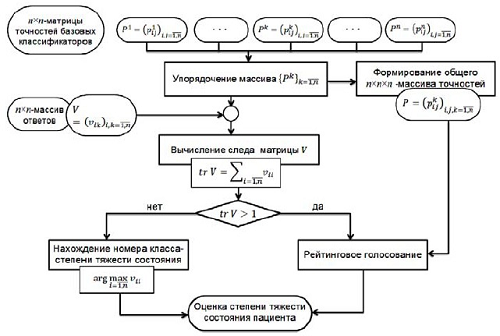Information technology for patient’s grade of severity estimation
DOI:
https://doi.org/10.15587/2313-8416.2014.27256Keywords:
information technology, patient’s grade of severity estimation, supervised classification, compositions of classifiers (classifiers ensembles)Abstract
The information technology for patient’s grade of severity estimation is suggested in the paper. The information technology is based on the methods of supervised classification and algorithms compositions constructing, which were developed by the author. The results of information technology applying for real data to estimate grade of severity for 232 patients with pancreas traumas, are reported.
References
1. Fleming, W. R., Collier, N. A., Banting, S. W. (1999). Pancreatic trauma: Universities of Melbourne HPB Group. Aust. N. Z. J. Surg., Vol. 69, No. 5, 602–605.
2. Potanina, O. K., Dorfman, A. G., Shvyrev, S. L., Zarubina, T. V., Petrova, M. V. (2011). The experience of using foreign diagnosis nonspecific prognostic models for patients of surgical and oncological profiles. Vestnik RNCRR (Journal (Herald) of RSCRR), 3, 74–85.
3. Tyurin, A. S. (2013). Prediction and assessment of the quality of treatment for patients with fractures of the pelvis with associated trauma, 18.
4. Ivanov, P. A., Grishin, A. V., Korneev, D. A., Zinyakov, S. A. (2003). Injuries of pancrea-duodenal organs. Hirurgiya (Surgery). Juranal imeni N. I. Pirogova, 12, 39–40.
5. Vityuk, T. V., Domans’ky, B. V., Baramiya, N. A. (2002). Surgical treatment of open and closed pancreas injuries. Problemy viyskovoi ohorony zdorov’ya, 11, 387–395.
6. Young, P. R., Meredith, J. W., Baker, C. C. (1998). Pancreatic injuries resulting from penetrating trauma: a multi-institution review. Am. Surg., 64 (9), 838–843.
7. Hannan, E. L., Farrell, L. S., Gorthy, S. F. (1999). Predictors of mortality in adult patients with blunt injuries in New York State: a comparison of the Trauma and Injury Severity Score (TRISS) and the International Classification of Disease, Ninth Revision-based Injury Severity Score (ICISS), 47 (1), 8–14.
8. Yaroshetskiy, A. I. (2006). Integrated assessment of patients’ state and prognosis in a case of severe multi-trauma, 26.
9. Nessonova, M. N. (2014). The method to develop classifiers based on geometrical interpretation of data structure. Actual’ni pytannya pharmacevtychnoi I medychnoi nauky i praktiki, 1 (14), 101–103.
10. Nessonova, M. N. (2013). Metric approach based classifier. Book of abstracts of all-Ukrainians scientific and practical conference of students and young scientists «Actual questions of development of new medicines», 269.
11. Nessonova, M. N. (2013). The rate voting of mixture of experts algorithm in supervised classification problems. Zaporozhskiy medicinskiy zhurnal, 1 (76), 101–102.
12. Nessonova, M. N., Kochina, M. L. (2014). Methods to estimate patient’s grade of severity. Kibernetika i vychislit’l'naya tehnika, 175, 74—87.
13. Djuk, V. A. (2002). Smithereens of knowledge. Express-Electronics, 6, 60–65.
14. Lbov, G. S., Pestunova, T. M. (1985) Grouping objects in heterogeneous featured space (in Non-numerical information analysis in social science), 226.
15. Vorontsov, K. V. (2012). Lecture notes on logical classification algorithms. Available at: http://www.ccas.ru/voron/download/LogicAlgs.pdf.
16. Aivazyan, S. A., Buchstaber, V. M., Yenyukov, I. S., Meshalkin, L. D. (1989). Applied statistics: Classification and reduction of dimensionality: Reference Edition. Moscow: Financy i statistika, 607.
17. Kuncheva, L. I. (2004). Combining pattern classifiers: methods and algorithms. Hoboken, New Jersey: A Wiley- Interscience publication, 360.
18. Osborne, M. L. (1977). The seniority logic: A logic for a committee machine. IEEE Trans. on Comp., Vol. C-26, No. 12, 1302–1306.
19. Congalton, R. G. (1991). A review of assessing the accuracy of classifications of remotely sensed data. Remote Sens. Environ., 37, 35–46.
20. Nessonova, M. N., Kochina, M. L. (2013). Applying results of the information technology for grade of severity estimation and clinical outcome prediction in a case of pancreas trauma. Clinical Informatics and Telemedicine, 10 (9), 102–107.

Downloads
Published
Issue
Section
License
Copyright (c) 2014 Марина Николаевна Нессонова

This work is licensed under a Creative Commons Attribution 4.0 International License.
Our journal abides by the Creative Commons CC BY copyright rights and permissions for open access journals.
Authors, who are published in this journal, agree to the following conditions:
1. The authors reserve the right to authorship of the work and pass the first publication right of this work to the journal under the terms of a Creative Commons CC BY, which allows others to freely distribute the published research with the obligatory reference to the authors of the original work and the first publication of the work in this journal.
2. The authors have the right to conclude separate supplement agreements that relate to non-exclusive work distribution in the form in which it has been published by the journal (for example, to upload the work to the online storage of the journal or publish it as part of a monograph), provided that the reference to the first publication of the work in this journal is included.
